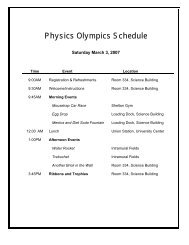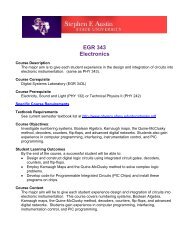Program - Physics & Astronomy - Stephen F. Austin State University
Program - Physics & Astronomy - Stephen F. Austin State University
Program - Physics & Astronomy - Stephen F. Austin State University
Create successful ePaper yourself
Turn your PDF publications into a flip-book with our unique Google optimized e-Paper software.
which lead to isolated early-type galaxies, we will be using theSloan Digital Sky Survey to search for other anomalously blueelliptical galaxies. We will compare the characteristics of thesegalaxies with those of the isolated systems previously studied.11:12 am - SPS-20 - Seeking Chemical and KinematicCorrelations in the Carina Dwarf Spheroidal Galaxy, GigiNevils, gknevils@shsu.edu, Derek Koger, stddlk12@shsu.edu,C. Renee James, phy_crj@shsu.edu, Sam Houston <strong>State</strong><strong>University</strong>, Matteo Monelli, monelli@mporzio.astro.it,Osservatorio Astronomico di Roma, Mario Nonino,nonino@ts.astro.it, INAF-Trieste. In this study, we haveanalyzed low-resolution spectra of a large sample of Carina starsto seek correlations between the kinematic properties and theabundance profiles in an effort to constrain both the chemicaland dynamical history of this intriguing object. Most notably, wehave found the following: Stars overlapping on the CMD canpossess vastly different radial velocities and different chemicalabundances, indicating that they are possibly not from the samegeneration; the hottest star possesses a metallicity well above thesolar [Fe/H] ratio; although there exists a wide spread inmetallicity and alpha-capture abundances, the spread does not atfirst glance appear to be related to the kinematic properties.11:24 am - SPS-21 - SFA Planet Finder, Kellie Fletcher,<strong>Stephen</strong> F. <strong>Austin</strong> <strong>State</strong> <strong>University</strong>, kelliefletcher@hotmail.com.SFA Planet Finder is a Visual Basic program designed tostreamline the process for finding solar system planets at theSFA Observatory.11:36 am - SPS-22 - The Effects of a Total Solar Eclipse onthe Low-Latitude Ionosphere at Two Different Altitudes, S.Zandstra and K. H. West, Texas A&M <strong>University</strong>-Commerce,Keith_West@tamu-commerce.edu. A total solar eclipse perturbsthe ionosphere by temporarily decreasing or eliminating thephotoproduction of plasma in a small portion of the ionosphere,as well as decreasing the heating of the atmosphere in thatregion. Ground based radar studies have shown that the effectsof this perturbation vary with altitude. In this study the effects oftwo solar eclipses on plasma composition and temperature areexamined using data taken in situ by instruments on boardspacecraft in the Atmospheric Explorer and DefenseMeteorological Satellite <strong>Program</strong> campaigns.11:48 am - SPS-23 - Gravity Probe B, Billy Albert, <strong>Stephen</strong> F.<strong>Austin</strong> <strong>State</strong> <strong>University</strong>, billyj81@yahoo.com. Efforts to testtheoretical phenomena resulting from Einstein’s Theory ofGeneral Relativity using a state of the art satellite are in motion.Gravity Probe B is the satellite and has been in orbit since April2004.12:00 pm - SPS-24 - SpaceShipOne, Chris Pierce, <strong>Stephen</strong> F.<strong>Austin</strong> <strong>State</strong> <strong>University</strong>, chrisp82_01@yahoo.com. Informationon the Ansari X-Prize and SpaceShip One: the first privatelyfunded spacecraft to leave the Earth's atmosphere.34



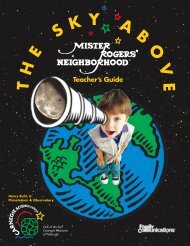
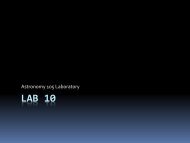
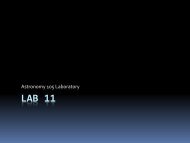
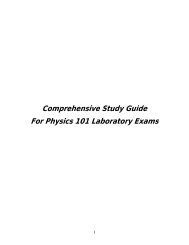

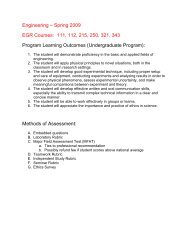
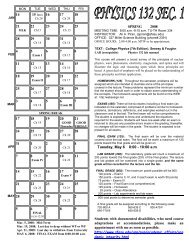
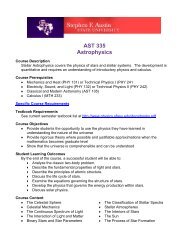

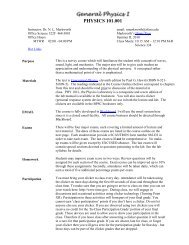
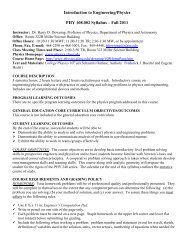
![[pdf] physics 110 fundamentals of electronics](https://img.yumpu.com/29312006/1/190x245/pdf-physics-110-fundamentals-of-electronics.jpg?quality=85)
